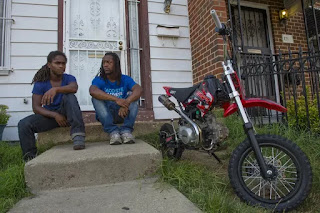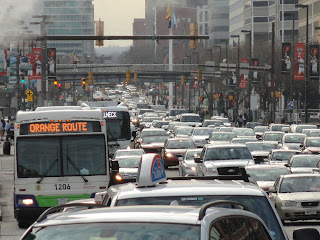The conversion of Baltimore's once industrial waterfront into a recreational area attractive for housing and business has steadily crept forward. From the Inner Harbor to Harbor East, from there to Fells Point, then to Canton. It leaped across the Inner Harbor along Key Highway (the Propeller Yard is now Ritz Carlton) to Locust Point.
Each step a new frontier and each a repeat of the same questions: Will this harm what we already have? Will this kill the last industrial jobs by pushing out too much industrial use? Do we really want this glitzy stuff or is this too much gentrification and finally: Will the roads be able to handle the traffic?
The latest new frontier has been for some time Canton Crossing. It pushes across a long-held boundary reserved for heavy industry: Clinton Street. Beyond Clinton Street in the wastelands of Exxon Oil tanks, the jungle of freight tracks, salt and coal piles and the oceans of vehicles unloaded from huge container ships Baltimore's industrial heritage was still alive under the rumble of trains and big trucks and the clanking of freighters.
 |
When the First Mariner Tower was the only thing out there
(2006) |
When Ed Hale's version of his trademark First Mariner Bank building on steroids became the areas landmark people ridiculed the architecture and the location but Hale saw himself as a visionary.
Presiding in his old money imitation board room high in his tower he submitted suburban style development plans that came under attack from two sides: from those who fought the incursion into the industrial domain (Hale himself, before becoming a banker had once owned a trucking company) and from those who thought his vision was way too suburban.
 |
this Elkus Manfredi rendering of the COPT development shows
how close it sits to tank farms |
The development area now submitted by COPT who bought the land in the most recent twist of a long tale had been in play for a cruise ship terminal, for mixed use and for offices, but it never really possessed any urbanity in any of the previous incarnations and in spite of interventions from even the State Office of Planning. It had always looked more like the part of Hale's early vision, that was actually built, the Canton Crossing shopping center, an actual traffic generator.
But now the new owner, COPT, has hired Elkus Manfredi archirects of Boston, the same firm that also dazzled UDARP with the Exelon Tower and they presented a real dense, urban design that appeared to include reasonable public access and finally solved the connection to the promenade which currently ends right around the corner in a Baltimore City Department of Public Works space that is also a remnant of a different past.
And yes, as predictable as Bubba Gump at the Inner Harbor, the question if the roads can handle the traffic is asked once again. Once more a traffic impact study is mentioned as needed to show how the development would handle the traffic and once more the only possible solutions seem to be either you build more road capacity or you reduce the development.
Baltimore still hasn't come to terms what it means to be a real city. In a real city you don't throttle development through pointing to failing intersections. In a real city you welcome development, the more and the denser, the better the city becomes. The more taxes are being taken in, the more people are out in the streets, the more services and jobs are provided , the more contacts made, the more synergies achieved. In short, exactly what cities are for.
 |
| COPT development plan under UDARP review (Elkus Manfredi) |
Some in Baltimore still haven't come to terms with the somewhat more complex thought process from which one concludes, the more density, the less traffic! Some in Baltimore still have not learned from Vancouver, Washington DC and many places in between or elsewhere in the world that urban density and rapid growth can bring a reduction in the usage of cars and traffic although upon further contemplation it is
 |
| Canton Crossing shopping: Popular but very auto oriented |
pretty obvious, how that works. People can do a lot of stuff without getting into a car. Imagine that.
It is ironic, though, that some of those very ones who fought the planned Baltimore Red Line that would have served thriving Canton, Canton Crossing and Brewer's Hill are now whining about congestion. But they can console themselves, I-95 is really close. (They could explore non-urban traffic congestion on the way to Bel Air, the lands of Governor Hogan).
Luckily, Baltimore's new development czar, BDC Chief William Cole has the right insight. He said when asked about congestion in conjunction with the dense COPT development:
"We'll work with the developer and all adjacent developers on any and all solutions that we can come up with to help ease traffic issues over there, but we live in a city and I don't believe we should base all of our decisions on traffic," he said. "These are urban areas, so density is generally a good thing."
Good for him. He got it!
Klaus Philipsen, FAIA
Baltimore Brew
article about the congestion and traffic debate
Baltimore SUN
article about the COPT project





































